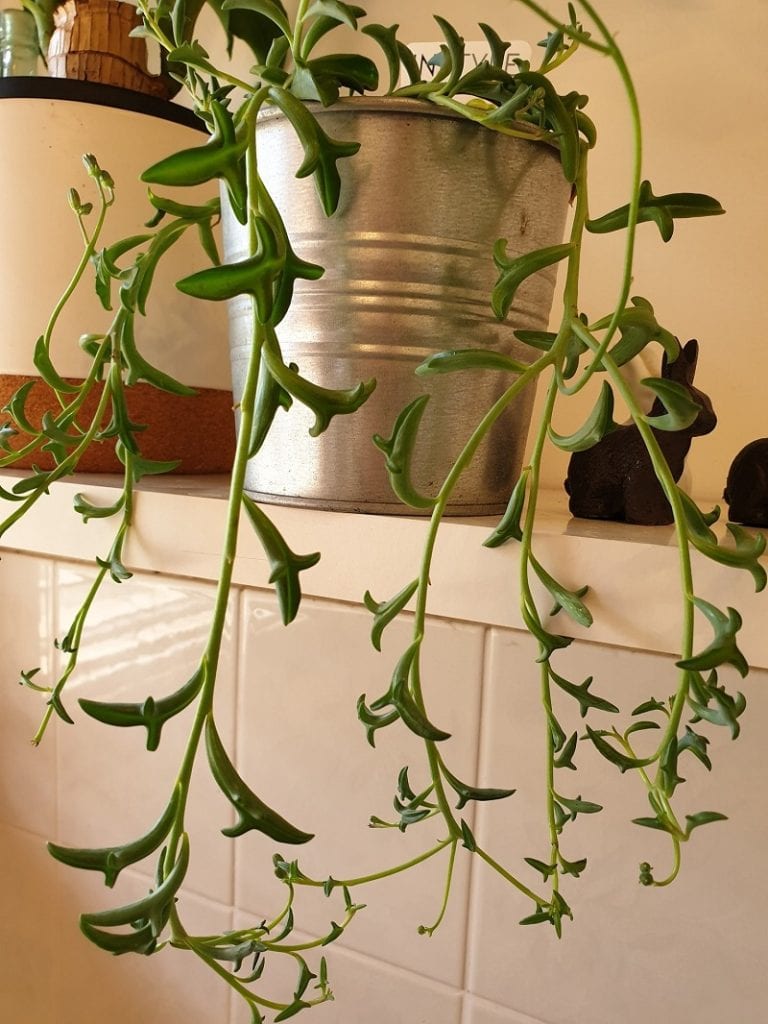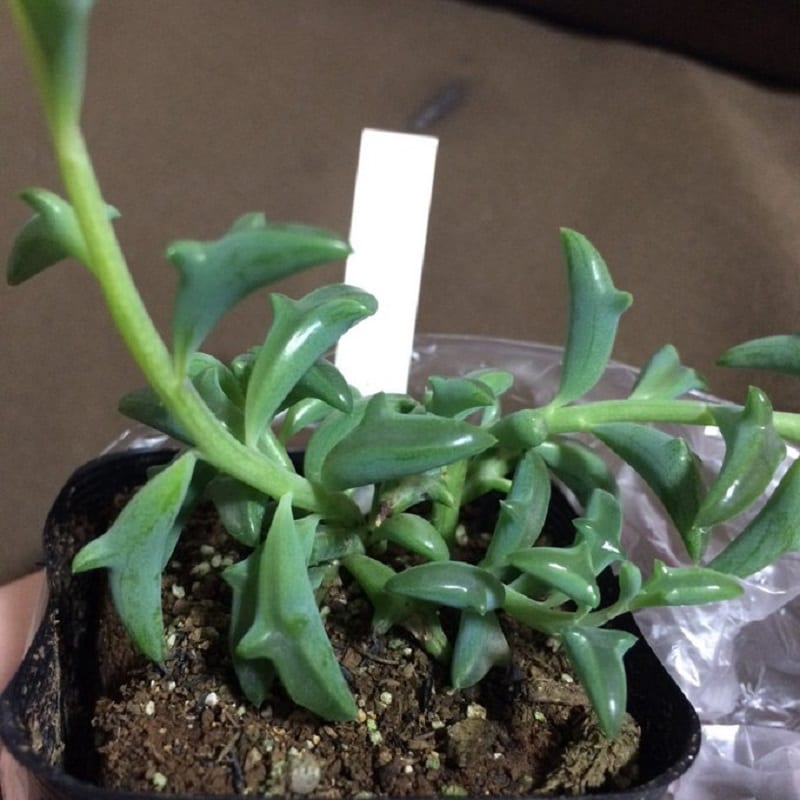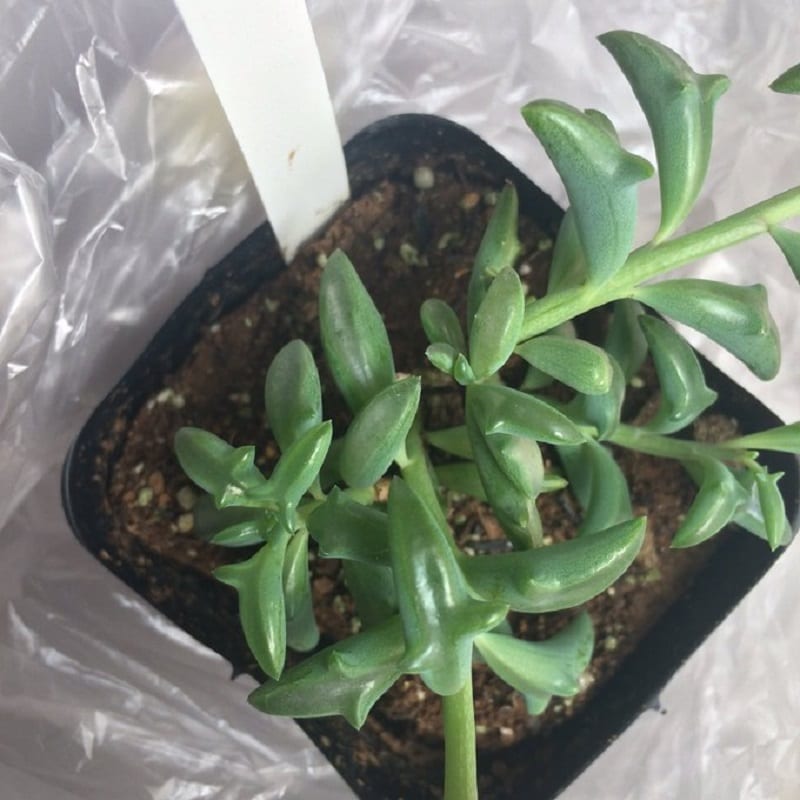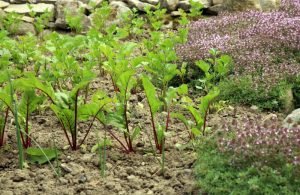Last Updated on October 30, 2025 by teamobn

(Photo: Meganesia/Wikipedia)
When it comes to sheer charisma and whimsy, few plants can beat Senecio peregrinus. This succulent’s common name is the dolphin plant and it’s the internet’s newest green craze.
The name is an apt description of the adorable plant. They develop leaves that quite literally look like jumping dolphins!
A Succulent with a Decidedly Aquatic Charm
Contents
By some accounts, the dolphin plant is a cross between a hot dog cactus and a string of pearls. Their unusual leaf form has typical succulent stoutness.
Dolphin plants are a huge hit in Japan. Their cute appearance, combined with the fact that they require little maintenance, makes it easy to see why.

Growing dolphin plants may be the closest thing you can come to having a pod of the aquatic mammals in your home!
While you’ll be hard put to find the plant in your typical nursery, many specialty growers offer them online.

Caring for Dolphin Plants
Caring for dolphin plants is simple, making them a great choice for both beginners and experienced plant lovers. These charming succulents require minimal maintenance but do best with the right balance of water, sunlight, and soil conditions. A little attention to their needs will ensure they thrive and continue producing their signature dolphin-shaped leaves.
Light Requirements
Dolphin plants flourish in bright, indirect sunlight. A spot near a sunny window with filtered light is ideal. Too much direct sun can scorch their delicate leaves, while too little can cause the vines to stretch and lose their compact, playful shape. If growing indoors, placing them near an east- or south-facing window provides the best lighting conditions. For outdoor growers, partial shade works well, especially in hotter climates.
Proper Watering
Like most succulents, dolphin plants prefer to dry out between waterings. Overwatering is one of the biggest threats to their health, as it can lead to root rot. During the active growing season in spring and summer, water them once a week, ensuring excess moisture drains completely. In fall and winter, when the plant enters dormancy, reduce watering to once a month. Keep an eye on the leaves—if they start to wrinkle, the plant needs more hydration.
Soil and Potting
Well-draining soil is essential for keeping dolphin plants healthy. A cactus or succulent mix works best, but adding perlite or sand to standard potting soil improves drainage. The container should have drainage holes to prevent excess moisture from collecting at the roots. Dolphin plants do well in slightly crowded conditions, making them perfect for small pots or mixed succulent arrangements.

(Photo: Kao77Neko/Twitter)
Temperature and Humidity
Dolphin plants thrive in warm temperatures between 65-75°F (18-24°C). They are not frost-tolerant, so if you’re growing them outdoors in a cooler climate, bring them inside before temperatures drop below 50°F (10°C). They adapt well to average indoor humidity levels but should be kept away from overly dry air, such as near heating vents.
Fertilizing for Growth
Although dolphin plants don’t require frequent feeding, a diluted succulent fertilizer can encourage healthy growth. Feeding once a month during the growing season is enough to keep them thriving. Avoid over-fertilizing, as too much can lead to excessive vine growth with fewer of the characteristic dolphin-shaped leaves.
Common Pests and Diseases
Spider mites and mealybugs can sometimes be a problem, especially in warm, dry environments. Regularly checking the undersides of leaves and using insecticidal soap or neem oil can help prevent infestations. Fungal diseases, often caused by overwatering, can be avoided by using well-draining soil and allowing the plant to dry between waterings.
Pruning and Maintenance
As the plant matures, older stems may become leggy or start to droop. Light pruning helps maintain a compact, bushy appearance. Trim back long vines and remove any damaged or dried-out leaves to encourage new growth. Propagating cuttings from pruned sections is an easy way to expand your collection or share with friends.
With the right care, dolphin plants will continue to thrive, offering a unique and playful addition to any home or garden. Their low-maintenance nature and charming appearance make them a delightful choice for plant enthusiasts of all levels.
The Origins of the Dolphin Plant
The dolphin plant, scientifically known as Senecio peregrinus, has captured the hearts of plant lovers worldwide with its whimsical, dolphin-shaped leaves. While its popularity is a relatively recent phenomenon, its origins trace back to a fascinating botanical lineage that combines beauty and adaptability.
A Hybrid Succulent with a Unique Heritage
The dolphin plant is not found in the wild as a naturally occurring species. Instead, it is a cultivated hybrid, created by crossing two distinct succulents: Senecio rowleyanus (string of pearls) and Senecio articulatus (hot dog cactus). This intentional hybridization resulted in a plant that inherited the cascading growth habit of string of pearls while developing the distinctive, plump, dolphin-like leaves from its other parent.
Native Regions and Growth Patterns
While the dolphin plant itself is a cultivated species, its parent plants originate from South Africa and Namibia, regions known for their dry, arid climates. These environments have shaped the plant’s resilience, giving it the ability to store water in its leaves and survive in drought-like conditions. This adaptation makes it well-suited for life as a houseplant, thriving with minimal care and requiring only occasional watering.
Rise in Popularity
Though it has been around for some time, the dolphin plant didn’t gain widespread attention until it became a social media sensation. As plant lovers began sharing images of its distinctive leaves online, it quickly went viral, earning a reputation as one of the most sought-after succulents. Japan was one of the first countries to embrace the dolphin plant craze, with its love for all things cute (or kawaii) making this quirky succulent an instant favorite.
Why It Stands Out
Unlike many succulents that have more common leaf structures, the dolphin plant’s playful, ocean-inspired form sets it apart. Each leaf resembles a tiny dolphin leaping through the air, complete with a curved body and fin-like projections. This rare leaf formation has made it a collector’s favorite, often sought after by plant enthusiasts looking for something beyond the typical succulent varieties.
Availability and Cultivation
Because it is a hybrid, the dolphin plant is not always easy to find in local nurseries. Instead, specialty growers and online plant shops often carry it in limited quantities. As demand has grown, more cultivators have begun propagating and selling dolphin plants, making them easier to obtain for enthusiasts around the world.
The dolphin plant’s origins reflect both botanical innovation and nature’s playful creativity. As it continues to grow in popularity, it remains a symbol of how unique and delightful houseplants can be.

Dolphin Plant vs. Other String Succulents
Dolphin plants stand out among string succulents due to their playful, dolphin-shaped leaves, but they share similarities with other trailing varieties. Understanding the differences can help plant lovers choose the best option for their space and care preferences.
Dolphin Plant vs. String of Pearls
The dolphin plant (Senecio peregrinus) is a hybrid of Senecio rowleyanus, commonly known as string of pearls. While both plants have cascading growth and thick, water-storing leaves, their appearances are distinct. String of pearls features small, round, bead-like leaves, resembling a delicate string of green pearls. Dolphin plants, in contrast, develop curved leaves that look like tiny dolphins, giving them a more whimsical and unique appeal. In terms of care, both plants have similar watering and sunlight needs, but dolphin plants tend to be slightly hardier and less prone to shriveling if underwatered.
Dolphin Plant vs. String of Bananas
Another close relative is Senecio radicans, also known as string of bananas. Like the dolphin plant, it has trailing vines with elongated, slightly curved leaves, but they resemble tiny green bananas rather than dolphins. Both plants thrive in bright, indirect light and require well-draining soil. Dolphin plants, however, tend to grow a bit slower than string of bananas, making them a better option for those who prefer a more compact growth habit.
Dolphin Plant vs. String of Dolphins
Some sellers list dolphin plants as “string of dolphins,” but the names are often used interchangeably. True dolphin plants (Senecio peregrinus) have distinctively shaped leaves with fin-like projections, while mislabeled string of dolphins plants may resemble a hybrid with less pronounced dolphin features. Checking the leaf shape carefully ensures you get an authentic dolphin plant.
Dolphin Plant vs. String of Tears
Senecio herreianus, known as string of tears or string of watermelons, has teardrop-shaped leaves with slight striping. While it shares the trailing habit and succulent nature of dolphin plants, its leaf shape is completely different. String of tears is often easier to find in nurseries and has slightly more delicate stems, requiring gentler handling.
Dolphin Plant vs. String of Hearts
Unlike other string succulents, Ceropegia woodii, or string of hearts, belongs to a different plant family. It has thin, heart-shaped leaves with a more vining structure. While both plants make excellent hanging displays, string of hearts is more forgiving of lower light conditions and has a softer, more delicate appearance compared to the fleshy, water-storing dolphin plant.
Which One is Best for You?
Choosing between these string succulents depends on personal preference and care style. If you want a rare, conversation-starting plant, the dolphin plant is an excellent choice. If you prefer faster growth and easier propagation, string of bananas or pearls might be better suited. No matter which one you pick, all these trailing succulents bring charm and greenery to any space.
Conclusion
The dolphin plant is a one-of-a-kind succulent that combines whimsical charm with easy care, making it a favorite among plant lovers. Its playful, dolphin-shaped leaves set it apart from other string succulents, while its low-maintenance nature makes it perfect for beginners. Whether displayed in a hanging planter or mixed with other succulents, this unique plant adds a fun and refreshing touch to any space.






